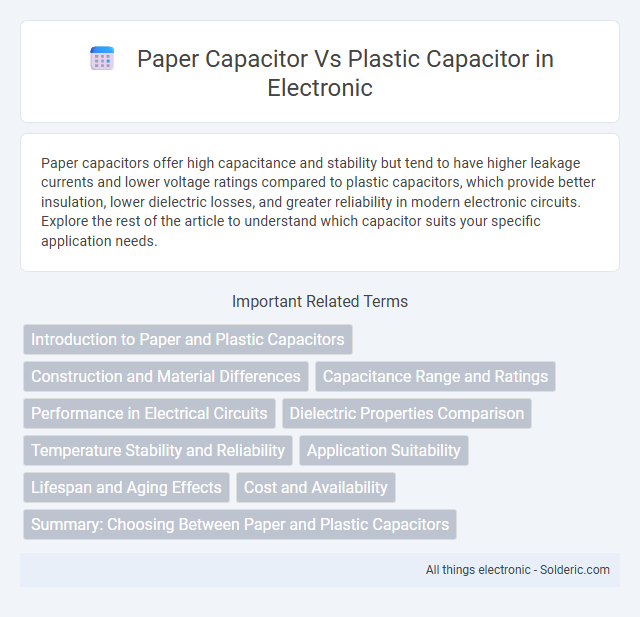Paper capacitors offer high capacitance and stability but tend to have higher leakage currents and lower voltage ratings compared to plastic capacitors, which provide better insulation, lower dielectric losses, and greater reliability in modern electronic circuits. Explore the rest of the article to understand which capacitor suits your specific application needs.
Comparison Table
| Feature | Paper Capacitor | Plastic Capacitor |
|---|---|---|
| Dielectric Material | Cellulose Paper | Polypropylene, Polyester, or Other Plastic Films |
| Capacitance Range | Few pF to several uF | Few pF to several uF |
| Dielectric Loss | Higher Loss, Less Efficient | Low Dielectric Loss, High Efficiency |
| Voltage Rating | Low to Medium | Medium to High |
| Temperature Stability | Poor | Excellent |
| Moisture Sensitivity | High, Affected by Humidity | Low, Moisture Resistant |
| Reliability | Lower Due to Aging and Moisture | High Long-Term Reliability |
| Cost | Generally Lower | Higher but Cost-effective for Performance |
| Applications | Retro Equipment, Audio Circuits | Modern Electronics, Precision Circuits |
Introduction to Paper and Plastic Capacitors
Paper capacitors use cellulose-based paper as the dielectric material, offering high insulation resistance and excellent voltage handling, making them suitable for high-voltage applications. Plastic capacitors employ synthetic polymer films like polyester or polypropylene, providing superior stability, low dielectric loss, and enhanced moisture resistance for precision circuits. Both types differ significantly in dielectric properties, voltage ratings, and reliability, influencing their selection in electronic designs.
Construction and Material Differences
Paper capacitors feature cellulose-based paper as the dielectric material, sandwiched between metal foil electrodes, offering high insulation resistance but limited moisture tolerance. Plastic capacitors employ polymer films such as polyester, polypropylene, or polystyrene as dielectrics, providing superior dielectric stability, lower loss, and enhanced moisture resistance compared to paper capacitors. The plastic dielectric layers are typically thinner and more uniform, enabling better performance in high-frequency and high-voltage applications.
Capacitance Range and Ratings
Paper capacitors typically offer capacitance values ranging from a few picofarads up to several microfarads, with voltage ratings around 100 to 600 volts, making them suitable for high-voltage applications but limited in lower capacitance precision. Plastic capacitors, particularly film types like polypropylene and polyester, provide a broader capacitance range from picofarads to tens of microfarads and can handle voltage ratings from 50 volts up to several thousand volts, ensuring high stability and reliability. The dielectric properties of plastic materials contribute to better capacitance tolerance and temperature stability compared to paper capacitors.
Performance in Electrical Circuits
Paper capacitors typically exhibit higher leakage currents and less stability under varying temperatures compared to plastic capacitors, which provide superior insulation resistance and consistent performance. Plastic capacitors, such as polyester or polypropylene types, offer lower dielectric losses and better frequency response, making them more suitable for precision and high-frequency electrical circuits. When optimizing Your circuit design for reliability and efficiency, plastic capacitors often outperform paper capacitors in maintaining stable capacitance and minimizing energy dissipation.
Dielectric Properties Comparison
Paper capacitors typically feature cellulose-based dielectric materials offering moderate dielectric constant and relatively high dielectric losses, resulting in lower efficiency for high-frequency applications. Plastic capacitors, using polymer dielectrics such as polyester, polypropylene, or polycarbonate, provide superior dielectric stability, lower loss tangent, and higher insulation resistance. Your choice influences overall circuit performance, especially in filtering and timing applications where dielectric properties critically affect capacitance stability and energy efficiency.
Temperature Stability and Reliability
Paper capacitors exhibit lower temperature stability compared to plastic capacitors, often experiencing significant changes in capacitance and increased dielectric losses at elevated temperatures. Plastic capacitors, such as polypropylene and polyester types, maintain consistent performance over a wider temperature range, ensuring higher reliability in demanding thermal environments. This enhanced temperature stability in plastic capacitors reduces aging effects and extends operational lifespan in electronic circuits.
Application Suitability
Paper capacitors excel in high-voltage and pulse applications due to their excellent insulation properties and high dielectric strength, making them ideal for vintage electronics and high-frequency circuits. Plastic capacitors, particularly those made from polypropylene or polyester, offer superior stability, lower dielectric loss, and better moisture resistance, which suits modern consumer electronics, audio equipment, and precision filtering tasks. Your choice depends on whether you prioritize high-voltage endurance or long-term reliability and performance in variable environmental conditions.
Lifespan and Aging Effects
Paper capacitors typically have a shorter lifespan compared to plastic capacitors due to their susceptibility to moisture absorption and dielectric degradation over time. Plastic capacitors, especially those made with materials like polypropylene or polyester, exhibit superior aging characteristics with lower capacitance drift and better stability under varying environmental conditions. The enhanced dielectric properties and resistance to environmental stress in plastic capacitors result in longer operational life and improved reliability in electronic circuits.
Cost and Availability
Paper capacitors are generally less expensive due to their simpler materials and manufacturing processes, making them widely available in traditional electronics markets. Plastic capacitors, including film types like polyester and polypropylene, tend to cost more but offer better longevity and reliability, which can justify their higher price in modern applications. Your choice may depend on balancing initial cost constraints with the availability of components suitable for your specific electronic design needs.
Summary: Choosing Between Paper and Plastic Capacitors
Paper capacitors offer high voltage ratings and stability in vintage or high-frequency applications but tend to have higher dielectric losses and lower reliability over time. Plastic capacitors, such as polypropylene or polyester types, provide superior insulation resistance, lower dielectric absorption, and enhanced durability, making them suitable for modern electronic devices requiring precision and longevity. When selecting a capacitor, your choice depends on the specific application demands, balancing factors like voltage, frequency response, and lifespan.
paper capacitor vs plastic capacitor Infographic

 solderic.com
solderic.com